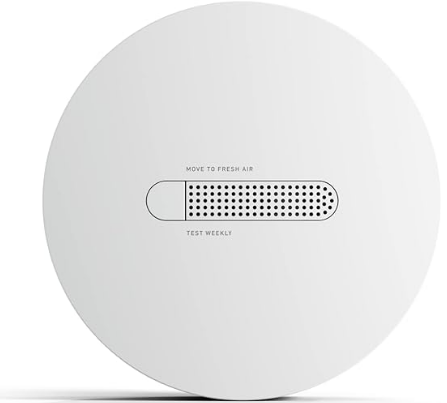SimpliSafe CA002 Smoke/CO Detector User Manual

PRODUCT INFORMATION
The SimpliSafe Wireless Smoke/CO Detector (CA002) is a combined photoelectric Smoke Detector and Carbon Monoxide Detector (referred to in this Owner’s Manual as the “Smoke/CO Detector”).
Smoke Detection
The Smoke/CO Detector is designed to sense smoke that comes into the detector chamber and gives early warning of developing fires with an alarm sound from its built-in siren. The built-in wireless transmitter also causes your SimpliSafe Base Station siren to sound. These sirens can provide precious time to escape before a fire spreads. However, such pre-warning of fire is only possible if the Smoke/CO Detector is located, installed and maintained properly as described in this Owner’s Manual.
Carbon Monoxide (CO) Detection
The Smoke/CO Detector also monitors the level of CO gas in your home and gives early warning when a potentially dangerous level exists. It does not detect any other gas. If a dangerous concentration of CO is detected, the red light on the front of the detector turns on and flashes four times, and an internal siren sounds The alarm automatically resets when CO is no longer detected.
INSTALLATION AND LOCATION
Always refer to your national and local codes before beginning any installation. Instructions for the State of California are detailed in Section A (ii) The Smoke/CO Detector should be installed in accordance with the NFPA
72 – National Fire Alarm and Signaling Code created by the National Fire Protection Association (NFPA).
The Smoke/CO Detector must be replaced within 10 years of the date of manufacture. This date can be found on the label on the back of the device.
Smoke/CO Detector Placement
Required Detection: where required by applicable laws, codes, or standard(s) for a specific type of occupancy, approved single and multiple station smoke alarms shall be installed as follows
- in all sleeping rooms and guest rooms
- outside of each separate dwelling unit sleeping area, within 21 feet (6.4m) of any door to his sleeping room, the distance measured along a path of travel
- on every level of a dwelling unit, including basements
- on every level of a residential board and care occupancy (small facility), including basements and excluding crawlspaces & unfinished attics
- in the living area(s) of a guest suite
- in the living area of a residential board & care occupancy (small facility)
Locations to Avoid
To avoid false alarms and optimize detection of real alarms, do not install a Smoke/CO Detector:
- In locations where combustion particles may normally be present, such as garages where there may be vehicle exhaust, near furnaces, hot water heaters, and space heaters. We recommend leaving at least 20 feet between the detector and such locations.
- In very dusty or dirty areas. Dirt and dust can build up on the sensing chamber, making it overly sensitive, or block openings to the sensing chamber, making it less sensitive.
- In insect-infested areas. If insects enter the sensing chamber, they may cause a nuisance alarm. Where bugs are a problem, get rid of them before putting up a detector.
- Near fluorescent lights. Electrical “noise” from fluorescent lights may cause nuisance alarms. Install Smoke/CO Detectors at least 5 feet (1.5 meters) from such lights.
- Near any cooking appliances. Install Smoke/CO Detectors at least 5 feet (1.5 meters) from any cooking appliances.
Install the Smoke/CO Detector on a ceiling or wall:
- Remove the mounting bracket from your unit by rotating it counterclockwise.
- Mount the bracket on the ceiling or wall, using the included screws and wall anchors.
- Push the Smoke/CO Detector onto the mounting bracket and turn it clockwise until it clicks into place. Pull outward on the detector to make sure it is securely attached.
NOTE: After you install the Smoke/CO Detector and whenever you change its battery, you must test it according to the instructions below to make sure it is functioning correctly

WARNING: Do not connect the Smoke/CO Detector to any other alarm or auxiliary device. Connecting anything else to this detector will keep it from working properly.
Battery Installation
- Open the battery compartment
- Install two CR123A 3V lithium batteries, making sure the + and – ends of the battery are aligned properly.
- After the batteries are installed and the Smoke/CO Detector is mounted on its bracket, you will see the green LED flash.
NOTE: Use only Panasonic or Duracell CR123A batteries. This Smoke/CO detector may not operate properly with other kinds of batteries.
Pairing to the Base Station
This section describes the basic steps for pairing the Smoke/CO Detector to the Base Station.
- Go to the Menu on the keypad and select “Setup and Naming”
- Press the Test Button on the Smoke/CO Detector.
- Name the Smoke/CO Detector on the keypad.
- Press “Done” to exit pairing.
USAGE, OPERATION AND OPERATING MODES
This Smoke/CO Detector CAN ONLY BE interconnected with other SimpliSafe alarms by connecting it to a SimpliSafe Base Station as specified in the Compatible Equipment Table below. This Smoke/CO Detector is not intended to be connected to any non-SimpliSafe devices or systems and you should not attempt to do so. Attempting to connect the Smoke/CO Detector to non SimpliSafe devices or systems may result in nuisance alarms, failure to alarm or damage to one or all of the devices in the non-SimpliSafe system
Normal Operation Testing
Before you test the Smoke/CO detector, make sure the detector does not have low batteries (Pg 19). If the Smoke/CO detector has low batteries, it will fail the self-test. Test your Smoke/CO Detector weekly by pressing the test button for 10 seconds. The sensor’s siren will sound and the light will flash at similar intervals.
WARNING: Never use an open flame of any kind to test your detector. You may damage it as well as your home. The built-in test switch accurately tests all functions as required by Underwriters’ Laboratories.
Silence Feature
Press the “Test/Silence” button (the white button on the front of the detector) to temporarily quiet an alarm for up to 10 minutes. If smoke is still present around the Smoke/CO Detector after 10 minutes of silence, the unit will re-alarm.
Smoke Detector Operating Modes
The LED light on the front of the Smoke/CO Detector indicates the operating mode of the unit:
- Red LED blinks 3 times rapidly: the Smoke/CO Detector has sensed a potentially dangerous level of smoke and is in smoke alarm mode. The buzzer and alarm siren will also sound. Please follow the “in case of fire” instructions.
- Green LED blinks about once per minute: the Smoke/CO Detector is functioning normally.
- Yellow LED blinks AND chirps once per minute: the Smoke/CO Detector battery is low. This low battery warning signal should last for up to 30 days, but you should install two new CR123A 3V lithium batteries immediately.
- Yellow LED blinks once and chirps 2 times every minute: this indicates the Smoke/CO Detector is in low sensitivity and needs to be cleaned.
- Yellow LED blinks twice and chirps 2 times every minute: this indicates the Smoke/CO Detector is in high sensitivity and needs to be cleaned.
- Yellow LED blinks once and chirps 3 times every minute: this indicates the Smoke/CO Detector is no longer operating within its intended sensitivity and must be replaced.
LIMITATIONS OF THE SMOKE/CO DETECTOR
Limitations of Wireless Smoke Detectors
Wireless smoke detectors cannot provide total protection of life or property and are not a substitute for insurance. All wireless smoke detectors are subject to possible compromise or failure-to-warn for a variety of reasons. For example:
- Smoke detectors require a source of power to work. This Smoke/CO Detector will not operate and the alarm will not sound if batteries are dead or not installed properly.
- Smoke detectors may not be heard. A sound sleeper or someone who has taken drugs or alcohol may not awaken if the detector is installed outside a bedroom.
- Closed or partially closed doors and distance can block sound.
- This Smoke/CO Detector is not designed for the hearing impaired.
- Radio signals transmitted by this Smoke/CO Detector may be blocked or reflected by metal objects. Adjacent devices or systems using radio frequency signals may interfere with the operation of this alarm.
- Test the system weekly to ensure signals are transmitted and received properly
- Smoke detectors may not detect smoke on other levels of the building.
Limitations of Wireless CO Detectors
Wireless CO detectors provide early warning of the presence of CO, usually before a healthy adult would experience symptoms. This early warning is possible only if your Smoke/CO Detector is located, installed, and maintained as described in this Owner’s Manual. 23 24 Because CO is a cumulative poison, long-term exposures to low levels may
cause symptoms, as well as short-term exposures to high levels. This unit has a time-weighted alarm. The higher the level of CO present, the sooner the alarm will be triggered.
FIRE PREVENTION AND ESCAPE
The purpose of an early warning smoke detector is to detect the presence of fire in its early stages and sound an alarm giving the occupants time to exit the premises safely. No detection device can protect life in all situations. Therefore, safeguards should be taken to avoid potentially dangerous situations as follows:
In Case of Fire
In the event of a fire, you should do the following:
- Leave immediately. Don’t stop to pack or search for valuables.
- In heavy smoke, hold your breath and stay low, crawl if necessary. The clearest air is usually near the floor.
- If you have to go through a closed door, carefully feel the door and door knob to see if undue heat is present. If they seem cool, brace your foot against the bottom of the door with your hip against the door and one hand against the top edge.
- Use your neighbor’s phone or a street fire alarm box to call the fire department. The job of extinguishing the fire should be left to the professionals.
REGULAR MAINTENANCE
To keep your Smoke/CO Detector in good working order, remove from mounting bracket, remove battery cover and vacuum the dust off the sensing chamber at least once a month.
- Remove the batteries before cleaning.
- Use soft brush attachment on your vacuum to carefully remove any dust, especially on the openings of the sensing chamber. Never use water or cleaners – they may damage the unit.
- Replace the batteries after cleaning.
- Test the detector to make sure the batteries are working correctly.
- Avoid spraying air fresheners, hair spray, paint, or other aerosols near the detector.
SPECIFICATIONS
Power Source:
- Required batteries: 2x Panasonic CR123A 3V lithium battery
- Smoke Sensor: Photoelectric 1.60 to 2.60 %/ ft obscuration sensitivity
- CO Sensor: Electrochemical
- Audible alarm: Over 85dB at 3m temporal pattern
- Sensitivity:Per UL217 and UL 2034
- Dimensions: 12 cm diameter x 4.5 cm
- Weight: 0.6 lbs




